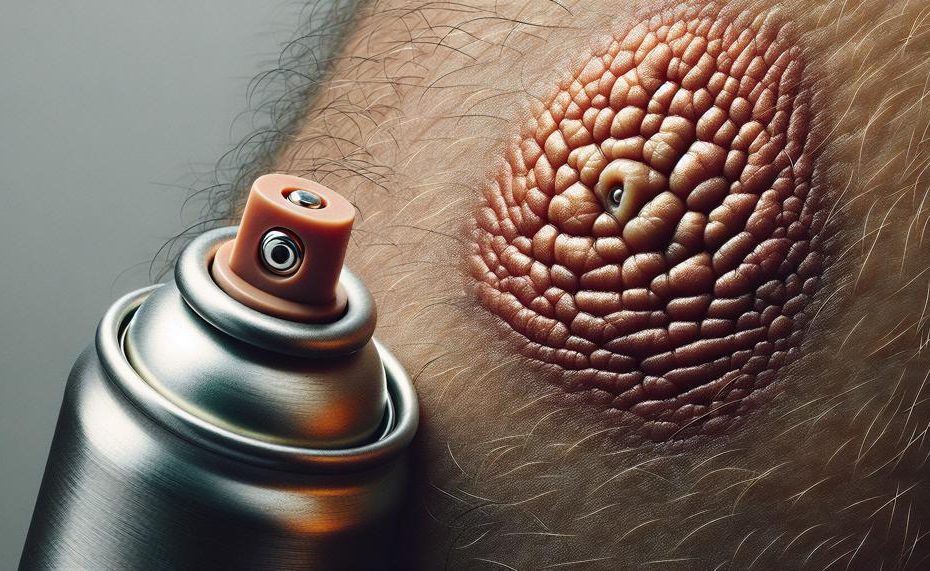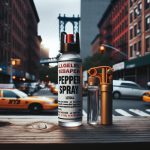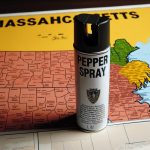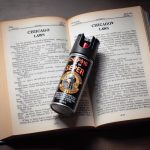Imagine this: you’re having a fun night out with your friends, dancing and enjoying some drinks. Suddenly, a heated argument breaks out and pepper spray is unleashed. In the chaos, you end up getting sprayed too. The burning sensation on your skin is excruciating and you’re desperate for relief.
But before you start panicking and rubbing your face with anything you can find, take a moment to breathe and read on. As someone who has experienced this firsthand, I’ve learned that removing pepper spray from skin requires a specific approach to avoid making things worse.
So, how do you get pepper spray off skin?
Pepper spray is oil-based, so it can be difficult to wash off. Here are some ways to remove pepper spray from skin:
- Wash with soap and water: Use a cleansing solution like hand soap, shampoo, or dish soap to break down and remove the oil. You can wash the area at least 8-10 times with cold water. Don’t rub the area during the first few washes.
- Rinse with vinegar: Rinse the area with a solution of equal parts water and vinegar for several minutes.
- Use cool water: Repeated cool water soaks may help relieve burning sensation or irritation.
- Use baby shampoo: Baby shampoo is a less-irritating alternative to soap. You can use a “no tears” baby shampoo to help rinse the pepper spray from the eye area.
- Apply petroleum jelly: Applying petroleum jelly before getting pepper sprayed can help it run off your skin instead of getting absorbed.
Now, let’s delve into how to effectively remove pepper spray from your skin without causing further irritation.
Contents
Flush with Cold Water
When dealing with the effects of pepper spray, it’s important to know how to flush it out properly. Flushing with cold water is an effective way to minimize the burning and irritation caused by capsaicin, the active ingredient in pepper spray.
By reducing heat and inflammation, cold water provides immediate relief. Additionally, it helps to remove any remaining particles of pepper spray from the skin’s surface.
It’s crucial to use cold water for this purpose, as hot or warm water can actually worsen the effects of pepper spray. After flushing with cold water, it’s recommended to cleanse the skin with a mild soap to ensure that all residue is removed.
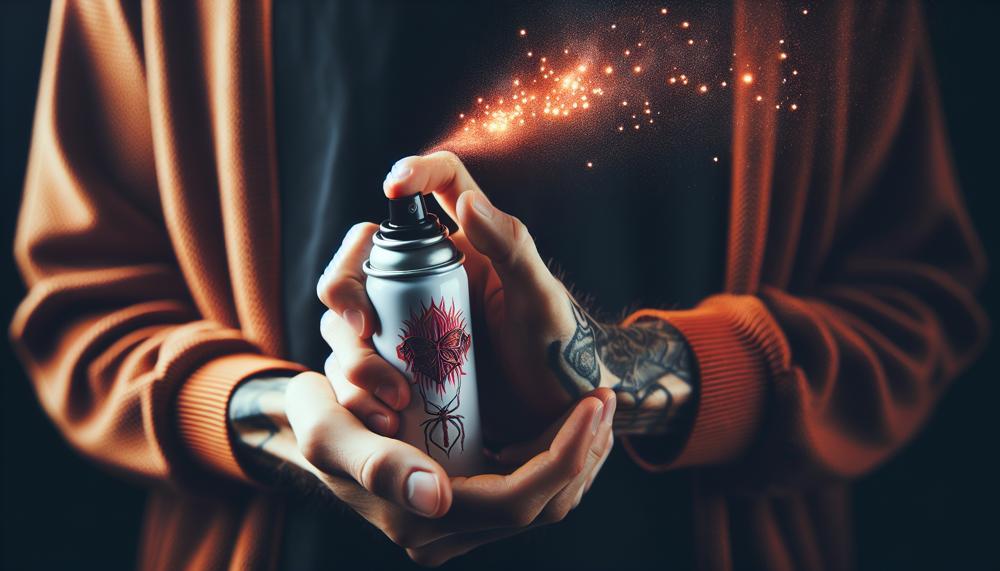
Other remedies like milk, baking soda paste, hydrogen peroxide, and vegetable/olive oil can also be used to neutralize the capsaicin and provide relief.
However, be careful not to touch or rub the affected area as this can spread the pepper spray and make symptoms worse. Seek medical attention if symptoms are severe. Prevention is key when it comes to pepper spray exposure, so always handle it with caution and use it responsibly.
To stay informed about self-defense tools like pepper spray, check out blogs at Security Forward. They provide valuable information on how to handle pepper spray and other self-defense techniques. Remember, being prepared and educated can make all the difference in dangerous situations.
Use a Mild Soap
When it comes to removing pepper spray from the skin, using a mild soap is crucial. This is because it effectively cleanses the affected area without causing further irritation or damage. Pepper spray contains capsaicin, a chemical derived from chili peppers that can cause intense burning and irritation on the skin.
While rinsing with cold water immediately after exposure can help reduce the effects of capsaicin, using hot or warm water can actually make it worse by opening up pores and allowing the chemical to penetrate deeper into the skin.
That’s why it’s important to use a mild soap that is free from harsh chemicals and perfumes. This type of soap will effectively remove any remaining pepper spray residue without causing additional discomfort. It’s best to avoid harsh or scented soaps as they can further irritate the skin and make the situation worse.
Aside from mild soap, there are other remedies that can help neutralize the effects of pepper spray. Dairy products like milk contain casein, which can break down capsaicin and alleviate the burning sensation. Baking soda paste, hydrogen peroxide, and vegetable/olive oil are also effective options for removing pepper spray from the skin.
During this process, it’s crucial to avoid touching or rubbing the affected area as this can spread the capsaicin and cause further discomfort. If symptoms persist or become severe, seeking medical attention is highly recommended. Symptoms such as difficulty breathing or intense pain should not be ignored and require immediate medical attention.
Apply Milk or Dairy Products
It is not recommended to use dairy products to remove pepper spray from the skin as they can trap the particles and prolong irritation.
Instead, it is best to rinse the affected area with cool water and use a non-oil-based soap.
| 1 | Milk | Full-fat milk contains proteins and fats that can help soothe the burning sensation caused by pepper spray. It also aids in neutralizing the capsaicin, the chemical responsible for the burning sensation. |
| 2 | Yogurt | Similar to milk, yogurt contains proteins and fats that can help alleviate the burning sensation by neutralizing capsaicin. It also has a cooling effect on the skin. |
| 3 | Sour cream | Sour cream contains lactic acid, which can break down capsaicin and provide relief from the burning sensation. It also has a cooling effect on the skin. |
| 4 | Cottage cheese | Cottage cheese is another dairy product that contains lactic acid and can help neutralize capsaicin. It also has a soothing effect on the skin. |
| 5 | Buttermilk | Buttermilk contains high levels of lactic acid, making it an effective option for neutralizing capsaicin and providing relief from the burning sensation caused by pepper spray. |
It is important to keep in mind that while dairy products may offer temporary relief from the burning sensation, they do not completely eliminate pepper spray from the skin. Therefore, it is crucial to thoroughly rinse the affected area with cool water and use a non-oil-based soap to fully remove the pepper spray particles.
Create a Baking Soda Paste
To create a baking soda paste for eliminating the effects of pepper spray on your skin, follow these steps:
- In a bowl, combine a small amount of baking soda with cold water to create a paste.
- Gently apply the paste onto the affected area and let it sit for 10 minutes.
- Rinse off with cool water and gently pat the skin dry.
- If necessary, seek medical assistance if experiencing intense burning or pain.
Baking soda, also known as sodium bicarbonate, is a versatile household ingredient with many practical uses. Its alkaline properties make it effective in neutralizing acidic substances such as pepper spray. By using a baking soda paste, you can safely and effectively remove pepper spray from your skin without causing further irritation.
To create the paste, mix a small amount of baking soda with cold water in a bowl. The consistency should be thick enough to easily spread onto the affected area. It is important to use cold water as warm or hot water may activate the pepper spray and worsen the discomfort.
Carefully apply the paste onto the affected area, being cautious to avoid contact with your eyes or mouth. Allow the paste to sit for 10 minutes to allow it to penetrate and neutralize the residue of the pepper spray. After 10 minutes, rinse off the paste with cool water and gently pat your skin dry.
While this method may provide temporary relief, keep in mind that it may not completely eliminate all traces of pepper spray. If you experience severe burning or pain, it is best to seek immediate medical attention. Additionally, remember to wash any clothing or objects that may have come into contact with pepper spray to prevent further exposure.
Try Hydrogen Peroxide
Hydrogen peroxide is a versatile and potent cleaning agent that is known for its ability to effectively remove pepper spray from the skin. This powerful solution works by breaking down the active ingredient in pepper spray, called capsaicin, which is responsible for causing intense burning and irritation.
Here’s how hydrogen peroxide can help you remove pepper spray from your skin:
| Step 1: Flush with cold water | Step 2: Cleanse with mild soap | Step 3: Apply hydrogen peroxide |
| If you’ve been exposed to pepper spray, the first step is to flush the affected area with cold water for at least 15-20 minutes. This will help dilute the capsaicin and provide immediate relief. | After flushing the area, wash it with a mild soap and rinse thoroughly with cold water. This will help remove any residue left behind by the pepper spray. | Next, use diluted hydrogen peroxide on the affected area using a cotton ball or cloth. The solution will break down the capsaicin and disinfect the skin, providing even more relief. |
| Step 4: Repeat if necessary | Step 5: Seek medical attention if needed | Step 6: Avoid touching or rubbing the area |
| If the burning sensation persists, you can repeat this process until it subsides. | If you experience severe symptoms or have any underlying medical conditions, it’s important to seek medical attention immediately. | To prevent further irritation, it’s crucial to avoid touching or rubbing the affected area. You can also apply a soothing oil, such as vegetable or olive oil, to provide additional relief. |
Although hydrogen peroxide is a safe and effective solution for removing pepper spray from the skin, it’s important to note that it may cause slight stinging or irritation for some individuals. If this occurs, it’s recommended to stop using it and seek alternative methods or medical attention.
In addition to using hydrogen peroxide, it’s important to continue flushing the affected area with cold water and applying a mild soap to remove any remaining residue. It’s also recommended to wash any items that may have come into contact with pepper spray, such as clothing or personal belongings.
Use Vegetable or Olive Oil
When it comes to removing pepper spray from the skin, both vegetable and olive oil have been proven to be effective. These oils can break down the capsaicin, providing relief from the burning sensation.
However, it is important to note that they should not be used alone. Instead, they should be used in combination with other methods, such as flushing with cold water and using a mild soap.
To use vegetable or olive oil for pepper spray removal, follow these simple steps:
- Immediately flush the affected area with cold water for 15-20 minutes to minimize the effects of capsaicin.
- Gently cleanse the skin with a mild soap that is free from harsh chemicals and perfumes.
- Apply a small amount of vegetable or olive oil onto the affected area and gently massage it into the skin.
- Continue to rinse with cold water and repeat the process until the burning sensation subsides.
- If there is still discomfort, try creating a paste with baking soda or using a hydrogen peroxide solution in addition to the oil.
- Seek medical attention if severe symptoms occur, such as difficulty breathing or intense pain.
In addition to being an effective method for removing pepper spray, vegetable and olive oil can also act as a preventive measure. Before entering a potentially dangerous situation, rub some oil on exposed areas of your skin, such as your face and neck.
This creates a barrier between your skin and the pepper spray, making it easier to remove if necessary.
Avoid Touching or Rubbing the Area
Pepper spray is a potent chemical derived from chili plants that can cause intense pain and temporary blindness when sprayed on someone’s face. It is crucial to handle pepper spray responsibly and avoid any contact with the affected area to minimize the spread of its active ingredient, capsaicin, and prevent further discomfort.
Here, we will delve into the reasons why it is essential to avoid touching or rubbing the affected area after pepper spray has been applied.
Furthermore, we will provide useful tips to minimize its effects and ensure safety for both the user and others in the surrounding area.
| Reasons to Avoid Touching or Rubbing the Affected Area | How to Minimize the Effects of Pepper Spray |
| Spread of Capsaicin | To prevent further discomfort, it is crucial not to touch or rub the affected area as it can spread capsaicin and intensify the burning sensation. |
| Worsen Effects with Hot/Warm Water | To minimize the effects of capsaicin, flush the affected area with cold water immediately. Avoid using hot or warm water as it can open up pores and worsen the effects. |
| Avoid Harsh Chemicals and Perfumes | Cleanse the skin with mild soap and refrain from using harsh chemicals or perfumes that can further irritate the skin. |
| Use Milk or Dairy Products | Milk or dairy products can neutralize capsaicin and provide relief from the burning sensation when applied to the affected area. |
| Try Baking Soda Paste or Oils | For effective removal of pepper spray from the skin, try applying baking soda paste, hydrogen peroxide, or vegetable/olive oil to the affected area. |
In addition to these steps, it is crucial to seek medical attention if experiencing severe burning, difficulty breathing, or intense pain. Pepper spray can cause temporary blindness and severe discomfort for at least 30 minutes, depending on the strength and amount used.
Taking necessary precautions and handling pepper spray responsibly can minimize its effects and ensure the safety of everyone in the surrounding area.
Seek Medical Attention if Necessary
It is vital to seek medical attention if you experience any severe or concerning symptoms. These may include difficulty breathing, loss of consciousness, uncontrolled bleeding, and severe burns.
Furthermore, it is essential to keep in mind that pepper spray affects individuals differently. Some people may experience more severe symptoms than others. Therefore, it is crucial to monitor your symptoms closely and seek medical assistance if necessary.
In addition to physical symptoms, pepper spray exposure can also have psychological effects. It can cause fear, anxiety, and panic in some individuals. If you are experiencing any emotional distress after being sprayed with pepper spray, do not hesitate to seek professional help.
Also Read: Can Pepper Spray Blind You?
Conclusion
In conclusion, removing pepper spray from your skin requires a specific approach to avoid exacerbating the situation. It’s crucial to keep in mind that water can actually spread the capsaicin and make it worse, while dairy products like milk may offer temporary relief but also have the potential to clog pores and trap the chemical.
The most effective solution is an oil-based substance that can effectively break down the capsaicin and allow for easy removal.
To successfully remove pepper spray from your skin, it’s important to flush with cold water, use a mild soap, and refrain from touching or rubbing the affected area. Other remedies such as milk, baking soda paste, hydrogen peroxide, and vegetable/olive oil can also aid in neutralizing the capsaicin and providing relief.
However, if symptoms persist or become severe, seeking medical attention is highly recommended. Prevention is key when it comes to exposure to pepper spray, so always handle it with caution and use it responsibly.
Stay informed about self-defense tools like pepper spray by reading informative blogs at Security Forward. Being prepared and knowledgeable can make all the difference in dangerous situations.
